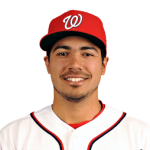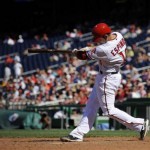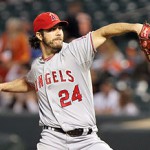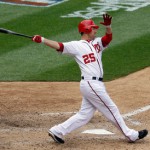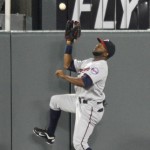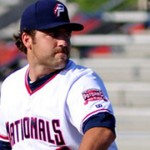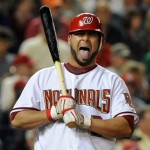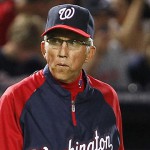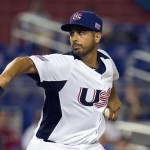
Mar 12, 2013; Miami, FL, USA; United States pitcher Gio Gonzalez (47) delivers a pitch against Puerto Rico at Marlins Park. Mandatory Credit: Scott Rovak-USA TODAY Sports
It’s been a while since Bill Ladson did an inbox; strange because you’d think with Spring Training in full swing he’d be getting a ton of emails. Here’s his 3/14/13 edition. Lets see if he takes a question on who will be the 2014 manager for the 5th consecutive time.
As always, I write my own answers before reading his, and edit questions for clarity as needed.
Q: Should the Nats be worried about sending their pitchers to the World Baseball Classic? Will there be pressure on them to pitch too many innings too soon?
A: Yes, this organization may be worried, as discussed in depth in Feburary in this space. We’ve never had a pitcher throw in the WBC who hasn’t come back either injured or less effective, and league-wide studies show the same trend. However I will say this: all 5 pitchers we’ve sent in years past were relievers. This year we sent two starters in Gio Gonzalez and Ross Detwiler. So maybe things will be different. Yes the concern basically is that these guys are more interested in getting outs than getting ready for the regular season, causing them to overthrow, to not prepare as they normally would in the spring, to not focus on specific things that they would normally do in spring training games. It is less about innings or pitch counts (which are strictly monitored). Ladson says the team isn’t worried about their arms, but is worried about the lack of playing time Eury Perez is getting. And they have a great point; Perez is sitting on the DR bench instead of getting ABs in spring training games. His chances of making the team dropped to zilch and he’s already been re-assigned to AAA.
Q: Who are going to be the lefties for the Nationals by Opening Day?
A: I’m assuming he means the “Lefty relievers.” At this point its looking like we’re going to break camp with just one lefty reliever in Zach Duke. Bill Bray needs more minor league time, Bobby Bramhall and Sean West are in minor league camp slated for AAA jobs, Brandon Mann got one inning and was awful, Pat McCoy got some innings but isn’t ready. Only Fernando Abad has stuck with the big-league team and looks good. But, if Henry Rodriguez is ready to go there’s no room for Abad. I’m guessing Abad goes to AAA and bides his time. Ladson agrees, and points out that our righties can get lefties out.
Q: With Tyler Moore on the big league roster, what do you think will happen to Chris Marrero?
A: I’m going to answer this my way, then i’ll predict what Ladson says. Chris Marrero goes back to AAA, burns his last option in the process, and bides his time waiting for injuries to take out the likes of Adam LaRoche and/or Tyler Moore. That seems to be the only way he gets opportunities this year. The team will hope for a strong AAA season to build up trade value and then will move him if they can. Otherwise he’s looking at a waiver wire trip this coming off-season. Now, before I read Ladson’s answer i’m going to guess that he says something along the lines of “The Nats will look to trade him for valuable assets” but he’ll neglect to mention that Marrero has zero trade value right now, having missed all of last year. Lets see if i’m right: I stand corrected; Ladson has finally come around on his stance on Marrero and says he’ll be in AAA all year.
Q: Would the Nats ever consider adding Kyle Lohse to the roster?
A: Consider? Perhaps. Actually do it? I don’t see it. Kyle Lohse is becoming the poster child for the problem with the Qualifying Offer in the new CBA. He foolishly declined it (on the advice of Scott Boras, who probably told him he could get 3-4 years guaranteed on the open market), and now sits unsigned 3 weeks from opening day. Its amazing; this guy was 16-3 last year! Lohse is seen as a product of his environment, a great coaching staff in St. Louis who do wonders with mediocre pitchers. And make no mistake; 2012 aside Lohse is a career 97 ERA+ pitcher with a .500 record and a 4.45 ERA. He doesn’t fit into the mold of what Mike Rizzo generally wants in a starter; power arm, high K/9 capabilities. Now, if the team bus crashed and we lost our starting rotation to injury tomorrow … yeah i’m guessing we’d give him a call. But there’s no way the Nats (or likely any other team) is going to give 3 guaranteed years to a 34-year old soft-tossing guy. Boras really, really miscalculated here and it looks like its going to cost his client millions. Ladson agrees.
Q: Please find out where Cole Kimball is in his rehab. I would like to know if he’s anywhere close to pre-surgery velocity.
A: I only saw Cole Kimball in one game, but his velocity was down. Perhaps its ramped back up later into spring training. In either case he’s bound for AAA to burn his last Option and await bullpen issues for his shot. Ladson says he’s “close to throwing 95-mph.” I wish more of these games were televised.
Q: Having heard earlier in the offseason that general manager Mike Rizzo feels Steve Lombardozzi and Danny Espinosa are both starters and not bench players, do you feel one of them will be traded prior to Opening Day? Lombardozzi was an extremely clutch pinch-hitter last year in my opinion.
A: Traded prior to Opening Day? Almost impossible; nobody makes trades at this point in the season. You make trades prior to spring training and then after a couple months are past in the season to address off-season or intra-season needs. We’ll save the Espinosa vs Lombardozzi vs Rendon discussion; we all know it by heart by now. Ladson says a trade is not coming.
Q: Considering he had a very good year with Triple-A Syracuse in 2012, what are the chances of outfielder Corey Brown making the team?
A: Zilch. He may have hit in AAA, but he didn’t hit squat with Washington last September. He’s at least 6th on the Washington OF depth chart (Werth, Harper, Span, Moore, Bernadina and then Eury Perez. Perhaps even lower; I think the team would give Carlos Rivero and Erik Komatsu chances before Brown at this point. And its just a matter of time before uber-prospect Brian Goodwin passes him by as well. Brown’s looking at another year of AAA time, burning his last option, and then getting the MLFA treatment. Ladson says no chance.
Hey! No question on the 2014 Nats manager this time! I stand corrected.
